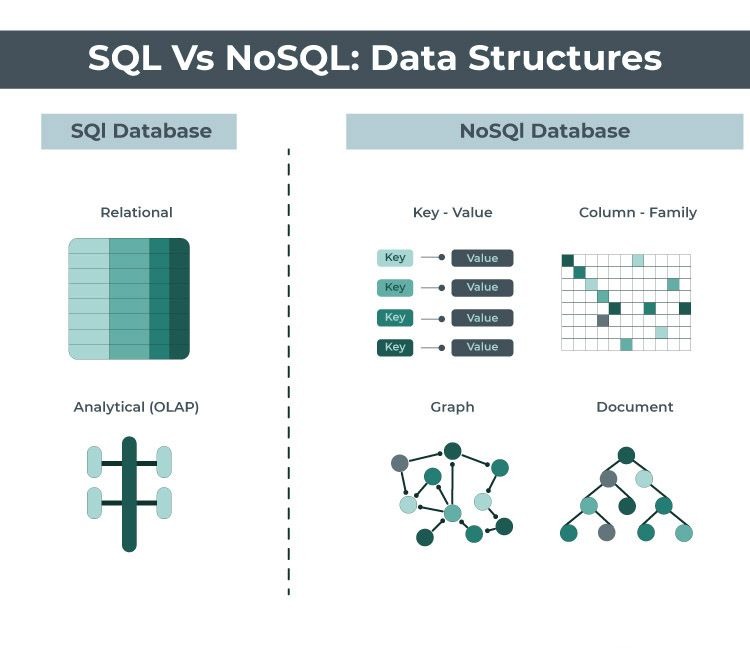Databases are the backbone of modern applications, enabling everything from storing customer information to powering AI-driven analytics. Whether you’re managing an online store, a social media platform, or a mobile app, choosing the right type of database—SQL or NoSQL—is crucial for performance and scalability.
In this article, we’ll break down how databases work, the differences between SQL and NoSQL, their advantages, and when to use each one.
1. What is a Database? 📊
A database is an organized collection of data that allows users to store, retrieve, manage, and analyze information efficiently.
🔹 Why Are Databases Important?
✅ Store massive amounts of structured and unstructured data.
✅ Enable fast searching, filtering, and reporting.
✅ Power applications like websites, mobile apps, and cloud computing systems.
🔹 Database Components:
- Tables/Collections – Organize data in a structured way.
- Indexes – Speed up searches.
- Queries – Retrieve and manipulate data.
- Transactions – Ensure data consistency.
The two main types of databases are SQL (relational databases) and NoSQL (non-relational databases). Let’s explore their differences!
2. SQL Databases: Structured & Relational 📜
🔹 What is SQL?
SQL (Structured Query Language) databases store data in structured tables with predefined schemas. They use rows and columns, similar to a spreadsheet, and follow strict relationships between tables (hence the name “relational database”).
🔹 Key Features of SQL Databases:
✅ Structured & Organized – Data is stored in tables with fixed columns.
✅ ACID Compliance – Ensures Atomicity, Consistency, Isolation, and Durability, which prevents data corruption.
✅ Powerful Query Language – SQL is a universal standard for managing data.
✅ Joins & Relationships – Tables can be linked via primary and foreign keys.
🔹 Popular SQL Databases:
🔹 MySQL – Popular for websites and small applications.
🔹 PostgreSQL – Advanced features, great for analytics.
🔹 Microsoft SQL Server – Common in enterprise environments.
🔹 Oracle Database – High-performance, used in finance and large-scale applications.
🔹 Example of an SQL Query:
This retrieves all users from the users table who are from the USA.
🔹 When to Use SQL Databases?
✔️ When data needs to be structured and consistent (e.g., banking, e-commerce).
✔️ For applications requiring complex queries and transactions.
✔️ When ACID compliance is necessary (e.g., financial applications).
3. NoSQL Databases: Flexible & Scalable 📂
🔹 What is NoSQL?
NoSQL (Not Only SQL) databases store data in a flexible, schema-less format, allowing faster and more scalable data management. Unlike SQL databases, NoSQL databases can store unstructured, semi-structured, and hierarchical data.
🔹 Key Features of NoSQL Databases:
✅ Schema-Free & Flexible – No need to define table structures in advance.
✅ High Scalability – Ideal for handling massive amounts of data.
✅ Fast Read & Write Operations – Great for big data and real-time applications.
✅ Different Data Models – Includes document stores, key-value stores, column-family databases, and graph databases.
🔹 Types of NoSQL Databases:
- Document-Oriented (e.g., MongoDB) 📝 – Stores data in JSON-like documents.
- Key-Value Stores (e.g., Redis) 🔑 – Fast access using key-value pairs.
- Wide-Column Stores (e.g., Cassandra) 📊 – Stores data in flexible columns, great for analytics.
- Graph Databases (e.g., Neo4j) 🕵️♂️ – Stores relationships between data points.
🔹 Example of a NoSQL Document (MongoDB):
Unlike SQL, there’s no need for predefined columns or table relationships.
🔹 When to Use NoSQL Databases?
✔️ When handling large-scale, high-traffic applications (e.g., social media, real-time analytics).
✔️ For flexible and evolving data structures (e.g., IoT, big data storage).
✔️ When horizontal scalability is needed (e.g., distributed cloud systems).
4. SQL vs. NoSQL: Key Differences 🆚
| Feature | SQL Databases 🏛️ | NoSQL Databases 🚀 |
|---|---|---|
| Data Structure | Structured, table-based | Flexible, unstructured |
| Schema | Fixed schema (predefined columns) | Dynamic schema (JSON, key-value) |
| Relationships | Uses joins & foreign keys | No strict relationships |
| Query Language | Uses SQL | Uses APIs or query languages like MongoDB Query Language |
| Scalability | Scales vertically (adds more power to a single server) | Scales horizontally (adds more servers) |
| Best for | Banking, transactions, structured data | Big data, real-time analytics, flexible applications |
5. Choosing the Right Database: SQL or NoSQL? 🤔
🔹 Choose SQL if…
✅ You need structured data with clear relationships.
✅ You require ACID compliance (e.g., banking, transactions).
✅ Complex queries and data consistency are critical.
🔹 Best for: Banking, financial applications, ERP systems, traditional business applications.
🔹 Choose NoSQL if…
✅ You handle unstructured or semi-structured data.
✅ You need fast, scalable solutions (e.g., IoT, big data, social media).
✅ Your application demands real-time performance.
🔹 Best for: Social networks, IoT data storage, big data analytics, recommendation engines.
6. Future Trends in Databases 🔮
🔹 Hybrid Databases – Combining SQL & NoSQL features for flexibility.
🔹 AI-Driven Databases – Predicting data trends and automating queries.
🔹 Serverless Databases – Fully managed, scalable cloud-based solutions.
🔹 Quantum Databases – Potential to revolutionize data processing speeds.
With the growing demand for real-time data processing, cloud computing, and AI-driven applications, databases will continue to evolve! 🚀
Conclusion 🏆
SQL and NoSQL databases each serve different purposes, and choosing the right one depends on your specific needs. SQL is best for structured data and transactions, while NoSQL is ideal for flexible, high-volume applications.
🔑 Key Takeaways:
✅ SQL databases are relational, structured, and best for financial and transactional applications.
✅ NoSQL databases are flexible, scalable, and ideal for big data, IoT, and real-time analytics.
✅ The right database choice depends on scalability, data structure, and performance needs.
💡 The future of data is a mix of SQL & NoSQL technologies working together! 🗄️💾

